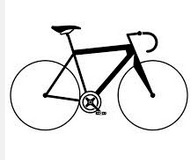Stories
* * *
Struggling with the United Nations
The Culture of Peace News Network continued
There are many speculations, in fact it is probably the dominant theory, that spoken language evolved out of gestural language. In that regard I have little to add.
What I can add, however, is how the brain mechanisms of such a complex behavior as language, which uses much of our brain, could have evolved. One needs to suppose that language, at first gestural language, made use of a complex brain mechanism that existed already because it served another purpose. OK, but what mechanism and what purpose, that is where there is lack of a good theory.
 I think I have the key, and it comes from work I did 40 years on the evolution of the supraspinal systems. Compare the fundamental structure of the organism to the simple bicycle shown here on the right. The hind wheels (= hind limbs) move the bike (animal) forward. They supply the power and and determine whether the animal moves. They do not steer. On the other hand, the front wheels decide whether the bike (animal) turns, and whether it turns right or left. This is not a power mechanism, nor does it determine whether the bike (animal) moves. It is simply a steering mechanism.
I think I have the key, and it comes from work I did 40 years on the evolution of the supraspinal systems. Compare the fundamental structure of the organism to the simple bicycle shown here on the right. The hind wheels (= hind limbs) move the bike (animal) forward. They supply the power and and determine whether the animal moves. They do not steer. On the other hand, the front wheels decide whether the bike (animal) turns, and whether it turns right or left. This is not a power mechanism, nor does it determine whether the bike (animal) moves. It is simply a steering mechanism.
The hind limbs are regulated by the reticulospinal tract, while the forelimbs are regulated by the tectospinal and rubrospinal tracts. This reflects a fundamental distinction between two separate brain mechanisms of locomotion: the midbrain reticular formation which decides IF the animal goes, and the tectum, and later, the forebrain extrapyramidal motor system which decides WHERE the animal goes.
Returning to the bike, it is perhaps not by chance that the biker steers with his forelimbs and provides the power and movement with his hindlimbs.
Over the course of evolution the midbrain locomotor system remains simple, while the forebrain extrapyramidal motor system becomes very elaborate, being overlaid with a pyramidal motor system in the mammals. Why? Because mammals, like birds (which do it differently), develop an internal map of the world that is used to guide their locomotion. This is a learned map. It cannot be genetically determined because each animal is born into a different terrain which requires a different map. It is this elaborate forebrain system for the determining the steering of locomotion according to an internal map that later on in evolution became the basis for language.
When our primate ancestors started walking upright it freed the forelimbs to be used for gestures, but even more important it freed the extrapyramidal and pyramidal motor systems with their internal map of the world to be used for a new task, gestural and eventually spoken language.
Hence, to understand the evolution of the brain mechanisms of language, we must start from the pyramidal and extra-pyramidal systems that evolved in order to control the direction of locomotion with reference to an internal map of the environment.
Thus, for example, if we are to use brain scan experiments, our subjects must not only speak and/or gesture, but also engage in tasks that orient their movement in the environment.
And since ontogeny often recapitulates phylogeny, our subjects should be primarily children at various stages of development.
Technically, the relevant experiments are still beyond the capacity of the latest brain research technology. What is needed is fine-grained, second-by-second brain scans linked with audio/video. Then one should be able to distinguish the brain activity differences between 1) speech plus gesture; 2) speech without gesture; 3) gesture without speech. And then one should also begin to distinguish different types of linguistic gestures, such as, for example, those that indicate movement in space. But, alas, there is no machine at Yale that can produce fine-grained, second-by-second brain scans of human activity.
After moving to France, I tried to contact a lab in Paris that had the machinery needed to do this research, but they did not reply to my mails and I decided that I was getting too old to undertake new scientific studies.
 |
Stages
1986-1992
Fall of Soviet Empire
1992-1997
UNESCO Culture of Peace Programme